Kinkaku-ji is a common name. Its formal name is Rokuon-ji.
Rokuon-ji Temple is a sub-temple of Shokoku-ji Temple.
Shokoku-ji Temple is a Grand Head temple of Rinzai Sect and possesses a very large site.
Shokoku-ji Temple was established around 1400 by Shogun Yoshimitsu Ahikaga.
Kinkaku was built in 1408. Then, Shogun Yoshimitsu invited Emperor and held a grand banquet to celebrate the completion.
The garden of Kinkaku-ji is one of the representitive garden that has a style of Japanese garden with a pond in the center during the Muromachi Period.
This garden is designated a special historic site and a place of special scenic beauty.
|
|
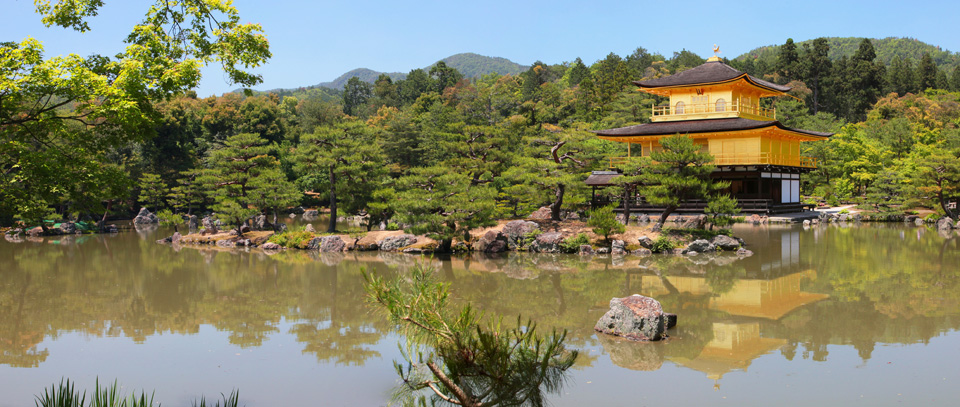 |
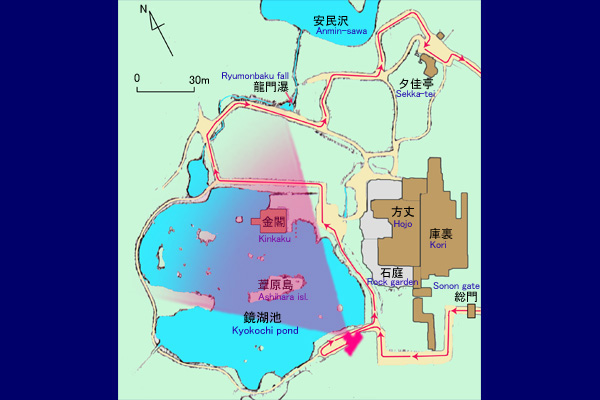 |
Kinkaku-ji and Kyokochi pond |
Following photoes of Kinkaku-ji are taken with while moving along the path.
You can realize the intention of garden creator, when you look at photoes comparing maps and location of islands, trees, plants and stones.
The trees, plants and stones add brilliant color to Kinkaku-ji.
The borrowing landscape behind Kinkaku-ji makes us feel depth and hamonized nature.
In a sense, it is a miracle that any modern building is not seen in the scenery.
We should respect the wisdom of the creator who desined this excellent garden. |
|
|
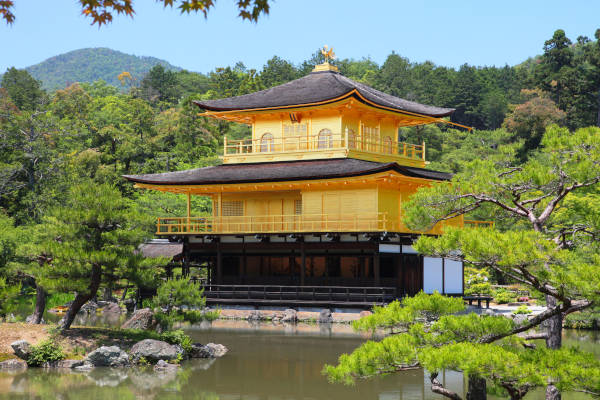 |
Kinkaku |
Kinkaku has three stage structure.
The first floor is Shinden-zukuri style.
Shogun Yoshimitsu seated statue and Shakanyorai statue are laid on this floor
The second floor is called Cho-on-do.
Iwaya Kan-non statue and Shiten-no statue are laid on this floor.
The third floor is called Kukkyo-cho.
It is Kyu Zen-shu style and has Kato-mado windows.
The ceiling and inner wall are covered with gold leaf.
The floor is painted with black japanese lacquer.
|
|
|
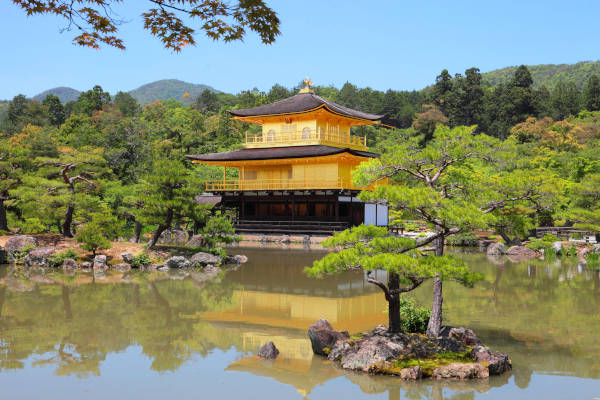 |
Kinkaku and Kinkyo-chi pond |
| The beautiful reflection of Kinkaku and borrowing landscape are seen on
Kyokochi pond. |
|
|
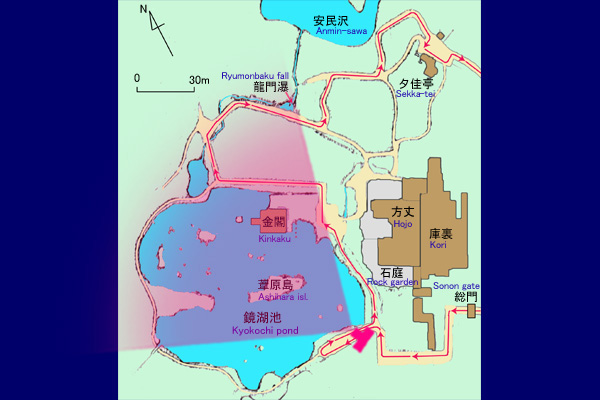 |
Kinkyo-chi pond whole view (panorama) |
Ashihara isl. seems to adjoin Kinkaku.
As the map shows, the pond extends beyond Ashihara isl. |
|
|
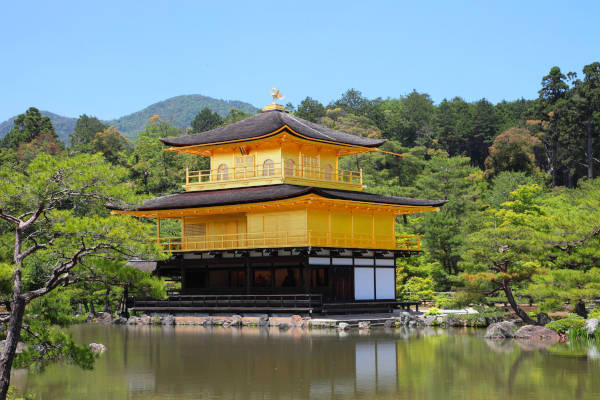 |
Kinkaku |
| After moving 10m from the former photo. |
|
|
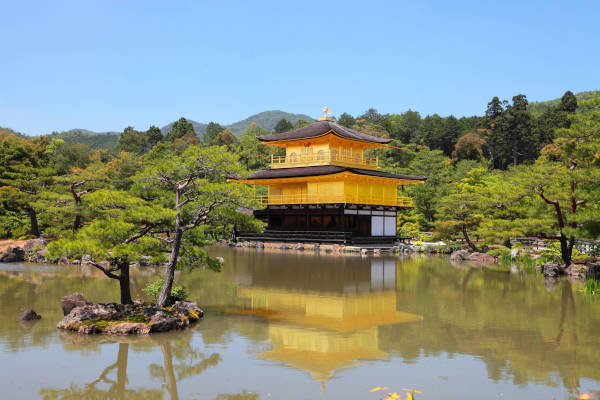 |
Kinkaku and Kinkyo-chi pond |
| After walking every some steps, the view of Kinkaku turns to a differnt faschinating figure. |
|
|
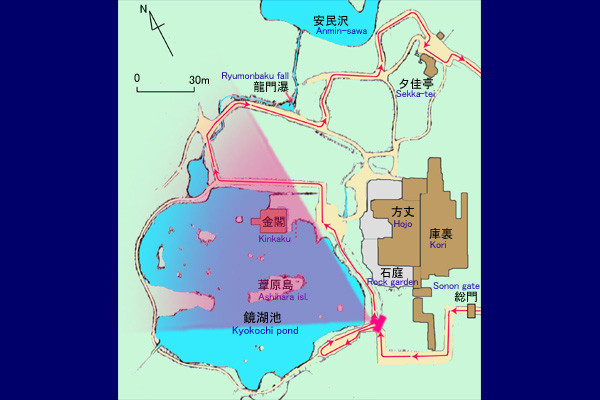 |
Kinkaku and borrowing landscape (panorama) |
The location of the island in front of Kinkaku indicates walking
steps.
Concerning the borrwing landscape, the right hand is a foot of Mt. Daimonji-yama and the left is a foot of Mt. Kinugasa-yama.
There is a residential area between two mountains.
But there can not be seen modern buildings.
If there were apartments, we would see them with Kinkaku.
Kyoto city has a strict regulation of architecture.
Over 15m height building is not permitted in the most area of Kyoto city.
Maximum height 30m is permitted in narrow districts.
Therefore beautful scenery of Kyoto city has been preserved. |
|
|
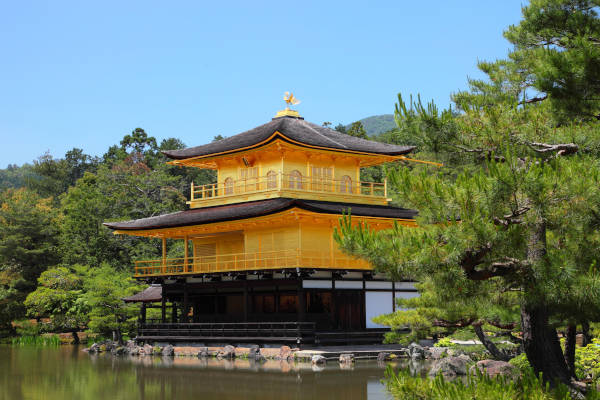 |
Kinkaku |
| The stone allocation of Kinkaku's base can be seen. |
|
|
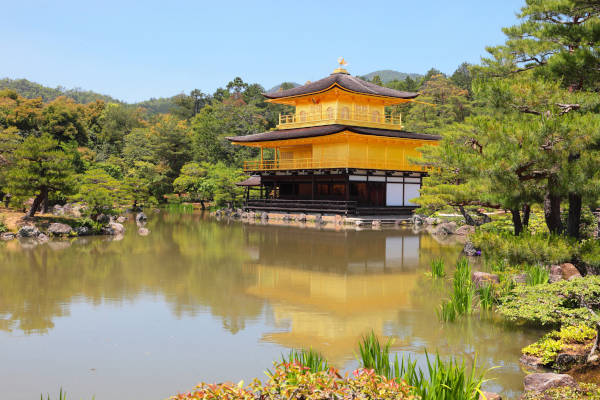 |
Kinkaku and pine |
| The right pine trees and plants contibute to faschinating view. |
|
|
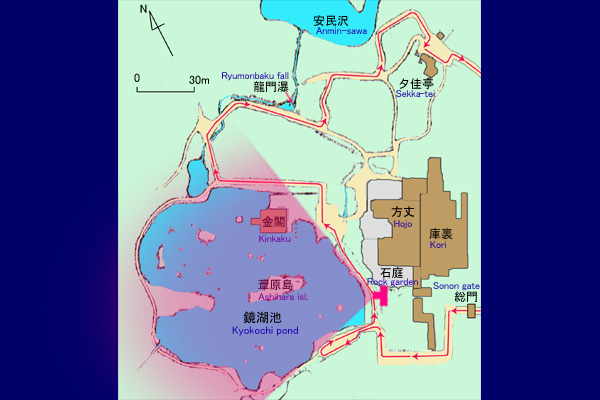 |
Kinkyo-chi pond whole view (panorama) |
| This spacious view makes our mind open and fresh. |
|
|
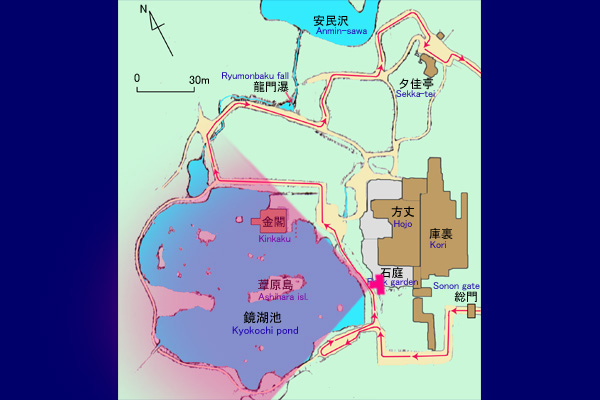 |
Kinkyo-chi pond whole view (panorama) |
| This scene seems broader than upper panorama after just walking some
steps. |
|
|
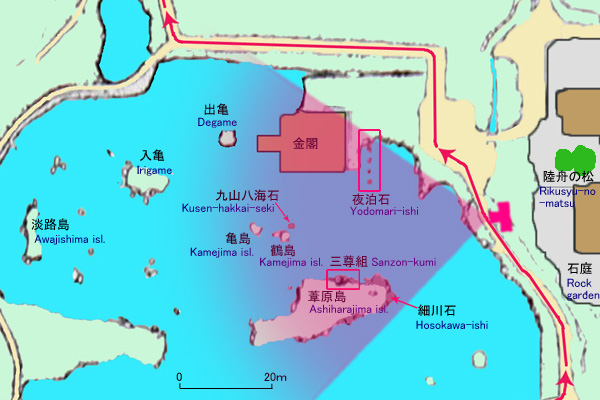 |
Kame-jima isl. and Tsuru-jima isl. |
There are islands between Kinkaku and Ashihara-jima isl.
Kame-jima isl. and Tsuru-jima isl. |
|
|
 |
Hojo |
Abbot's quarters.
Hojo was rebuilt thanks to donation of Emperor Gomizunoo. |
|
|
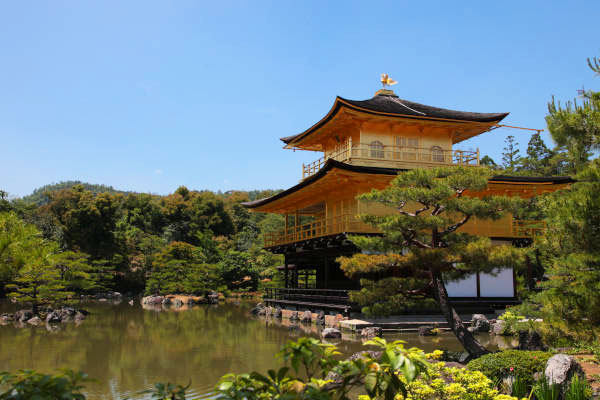 |
Kusenhakkai-seki |
Kusenhakkai means nine mountains and eight seas.
It is said that Utopia of Buddhism has nine mountains and eight seas.
This stone just manifests the scenery of Utopia.
[Reference] When mouse over, Kusenhakkai-seki can be seen.
 |
|
|
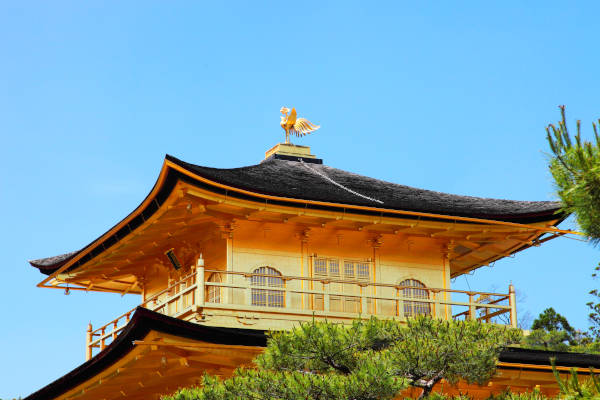 |
Ho-o (phenix) |
Original Ho-o was removed and has been kept.
Current Ho-o is made in 1987.
 Enlarged Fenix Enlarged Fenix |
|
|
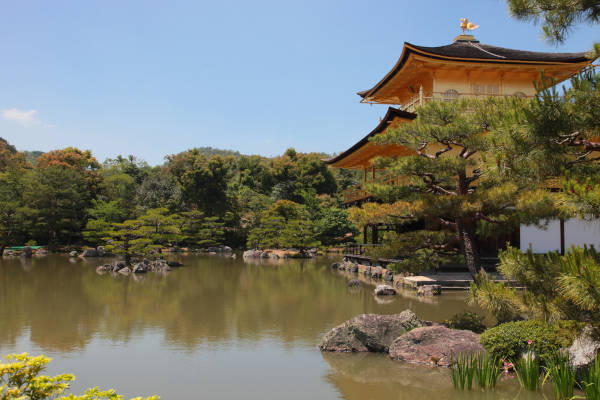 |
Kinkaku |
| Ishigumi is seen well. |
|
|
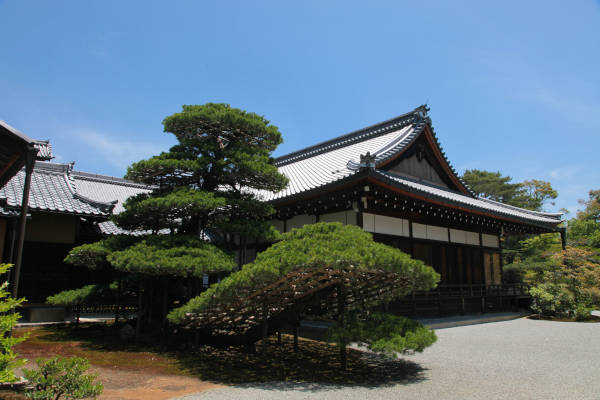 |
Hojo and Rikushu-no-matsu |
| The pine seems to be a boat somehow. |
|
|
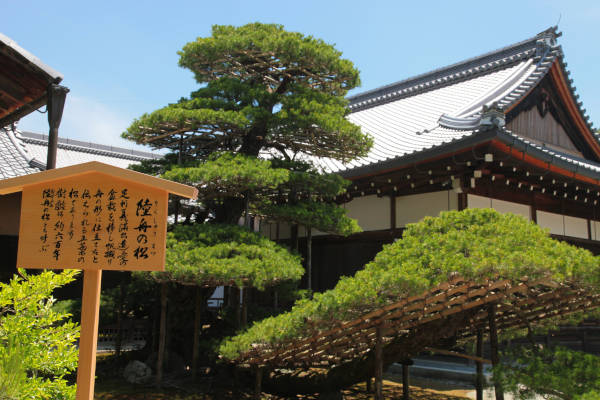 |
Rikushu-no-matsu |
It is said that Rikushu-no-matsu was planted by Shogun Yoshimitsu about 600 years ago.
One of the branch is sustained by bamboo lattice. |
|
|
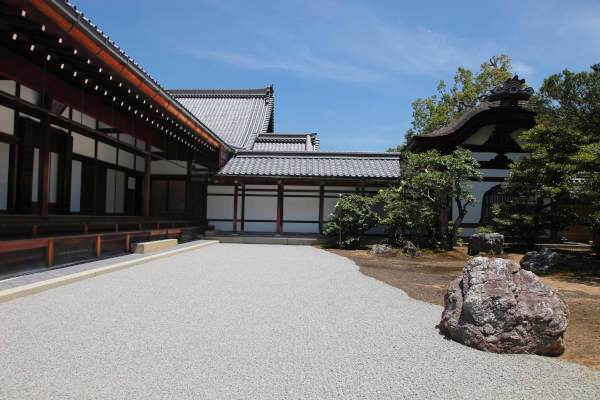 |
Rock garden |
The rock garden is located at the south side of Hojo.
There is few rock in the garden.
It has a simple style. |
|
|
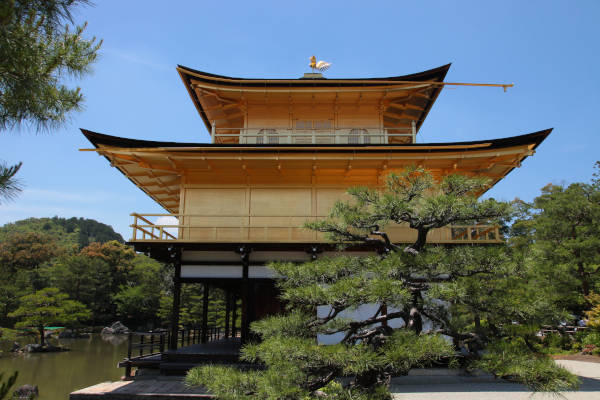 |
Kinkaku east side |
Kinkaku east side
The pond side of broad veranda is an architectural structure in which there are no walls. |
|
|
 |
Yodomari-ishi |
| Yodomari-ishi is three stones in a row at the lower left. |
|
|
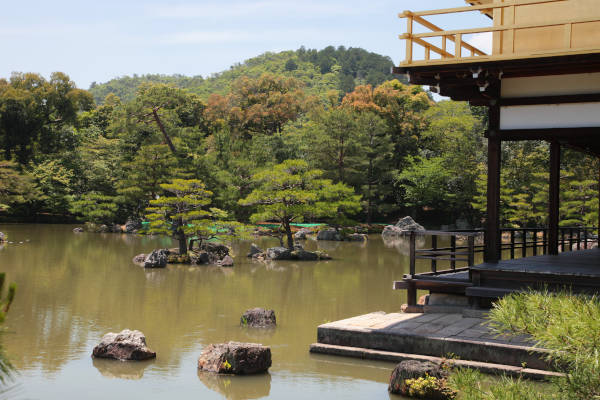 |
Yodomari-ishi |
| In general, it is said that the arrangement stands for ships in the port. |
|
|
 |
Sanzon-kumi |
Sanzon-kumi (three noble stones) can be seen at the center.
Central large stone is Shaka-Nyorai. The left is Monju-Bosatsu. The right is Hugen-Bosatsu.
|
|
|
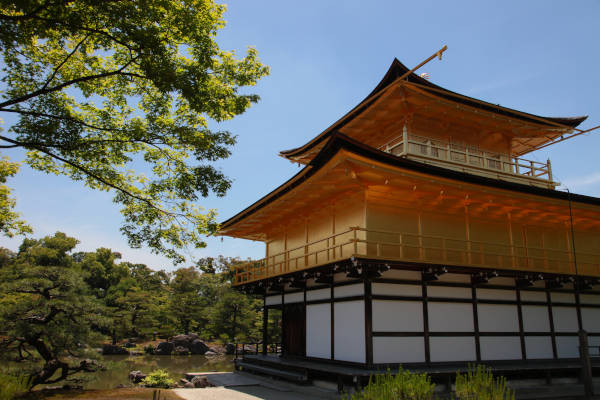 |
Kinkaku north side |
| Drainpipes are coming out at the corner of the top roof. |
|
|
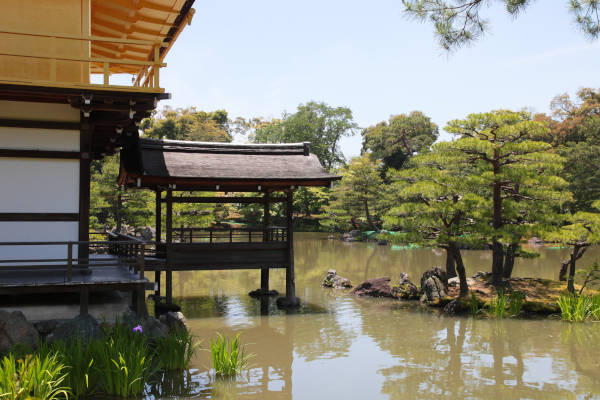 |
Sosei and Degame isl. |
Tsuridono (fishing house) is inevitable item of Shinden-zukuri.
It is called Sosei at Kinkaku.
It was also a funaya house for a pleasure boat.
The right island is Degame. |
|
|
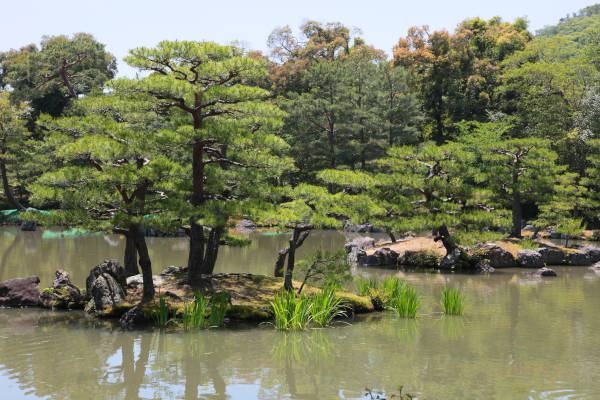 |
Degame isl. and Irigame isl. |
| The right is Irigame isl. and the left is Degame isl. |
|
|
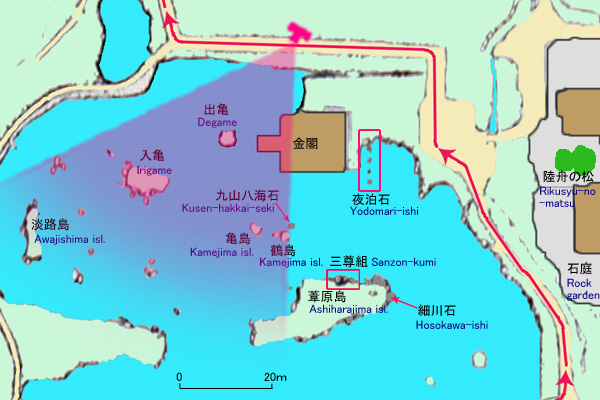 |
Kinkaku and Kyoko-chi pond |
Next to Kinkaku is Degame, Irigame and a part of Awaji-shima island.
The figure of Awaji-shima is similar to genuine one. |
|
|
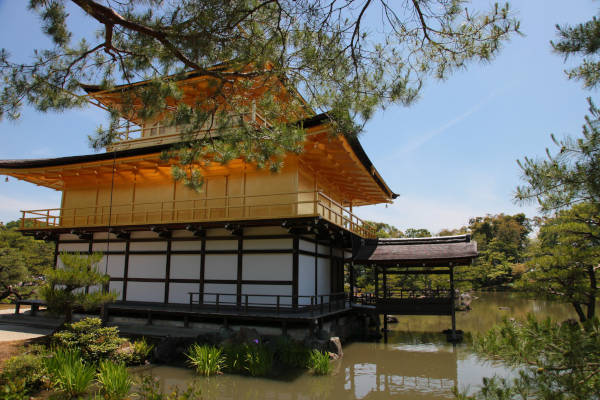 |
Kinkaku north side |
There is a city area beyond Kinkaku.
But modern buildings cannot be seen, thanks to architecture regulation of Kyoto city. |
|
|
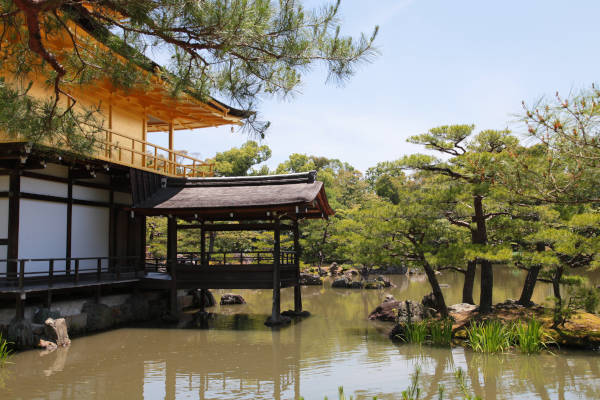 |
Kinkaku west side |
The sight of Kinkyo-chi pond ends here along the visitor's path.
It is regrettable that we can't walk half circle of Kinkyo-chi pond.
We would like to walk another half circle and see different angles of pond and Kinkaku. |
|
|
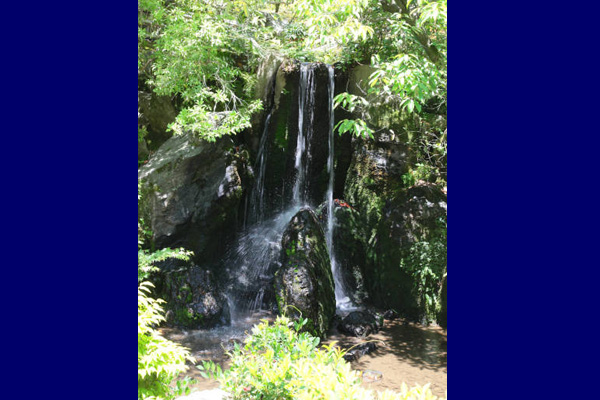 |
Ryumon-baku fall |
Rigyoseki stone is a large stone that stands at the center.
It expresses that a carp is jumping over the fall.
After jumped three falls, the carp is able to transform into dragon.
Ryumon means dragon gate.
Ryu-mon-baku is one of the important themes of Japanese garden creation during Kamakura and Muromachi Period. |
|
|
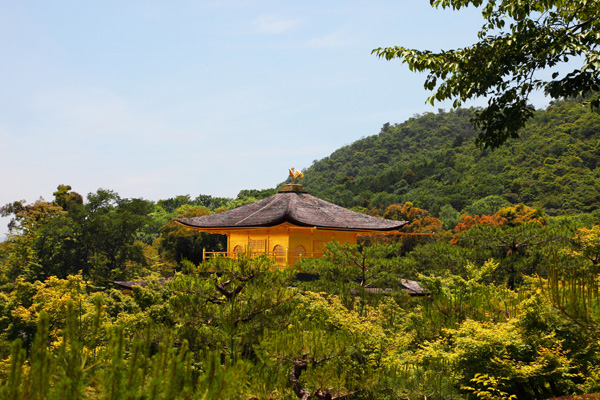 |
View of Mt.Kinugasa and Kinkaku |
Viewing from a hill.
This scenery is the same as Muromachi Period. |
|
|
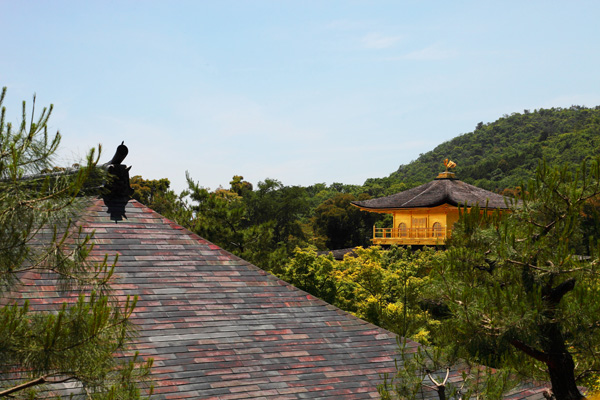 |
Kinkaku beyond the roof |
| This scene is a highly paintable landscape. |
|
|
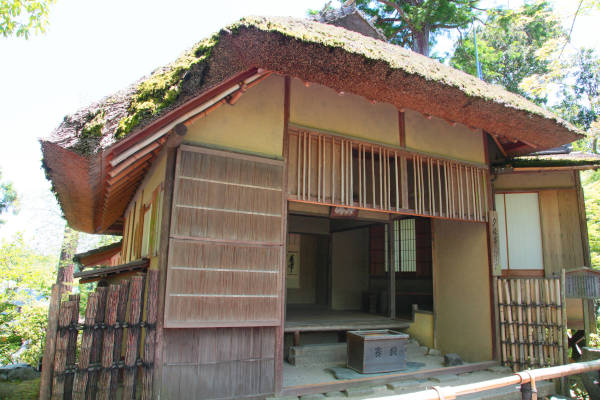 |
Sekka-tei |
Sekka means a good evening. In other words beautiful scenery can be seen in the evening.
From Seiun-ken, back tea room, shining Kinkaku in the sunset can be seen splendidly.
|
|
|
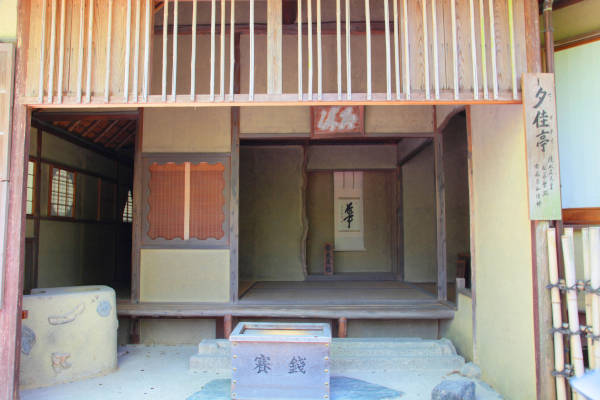 |
Sekka-tei entrance |
The creator of Sekka-tei is tea master Sowa Kanamori.
His characteristic designs are seen in many place. |
|
|
 |
Nanten Toko-bashira pillar |
Nanten Toko-bashira pillar is seen in Tokono-ma.
Attractive sinuous Nanten wood is used for the pillar. |
|
|
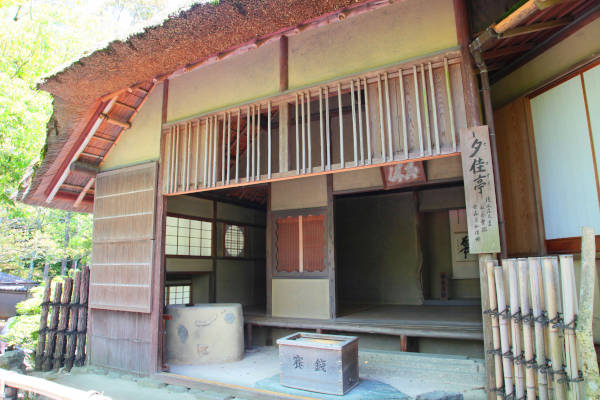 |
Sekka-tei |
Sekka-tei's architecture is Sukiya-zukuri with thatched roof.
Sowa Kanamori was fond of Sukiya-zukuri. |
|
|
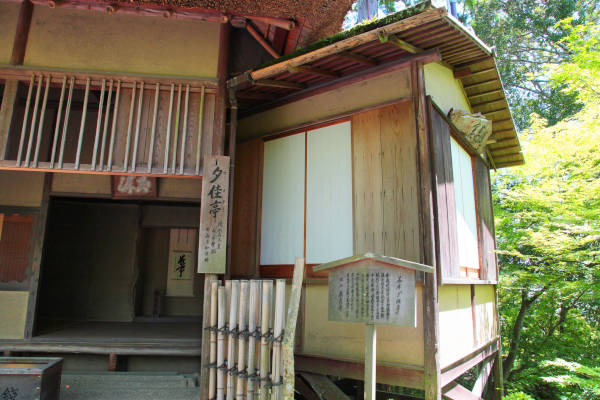 |
Hosei-ro |
Hosei-ro is only 2 tatamis room.
Retired Emperor Gomizunoo was entertained in this room. |
|
|
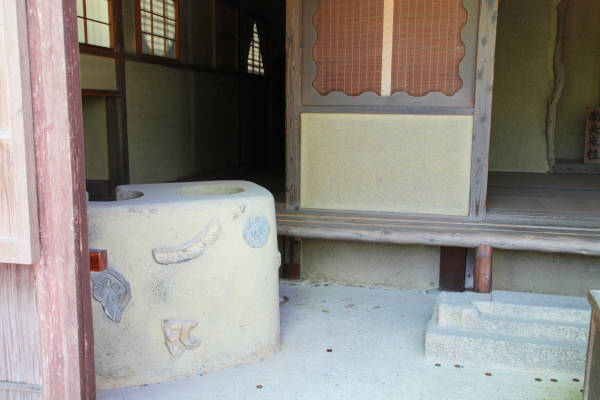 |
Doma |
The carachteristic stones are put in the left Kamado (cooking stove).
The shoe takeoff stone of the entrance is a rare three step stone. |
|
|
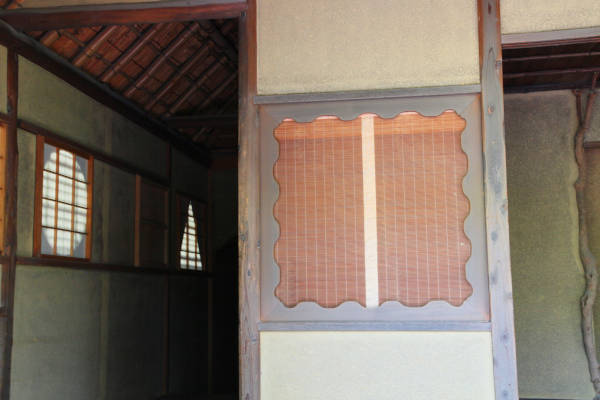 |
Sudare (bamboo window) and other windows |
Sudare attracts our attention.
Triangle and round windows on the soil wall are originative. |
|
|
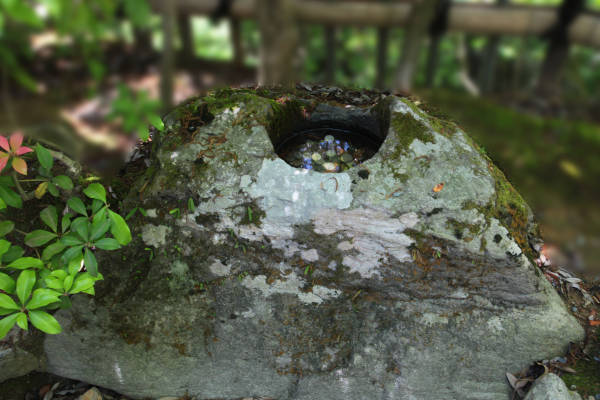 |
Te-arai-bachi |
| Eighth Shogun Yoshimasa loved this Mt. Fuji style washhand bowl. |
|
|
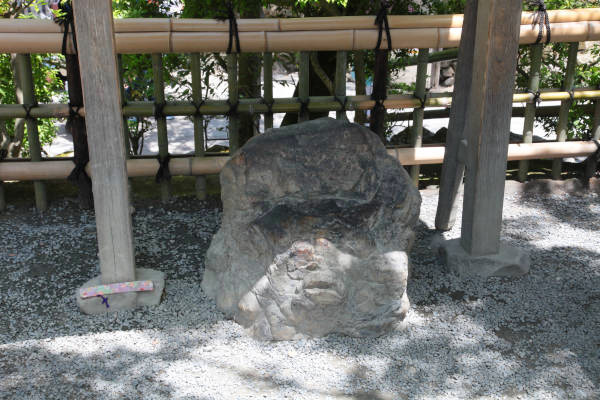 |
Kijin-to (chair for a noble) |
| They say that the stone like a chair was sat by a noble person while waiting
for a tea ceremony. |
|
|
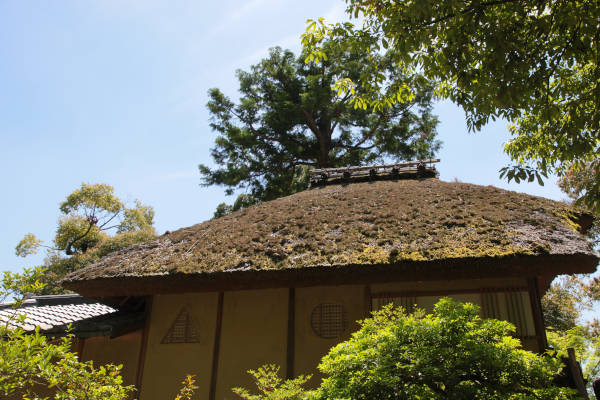 |
Sekka-tei north side |
| Outside of triangle and round windows can be seen. |
|
|
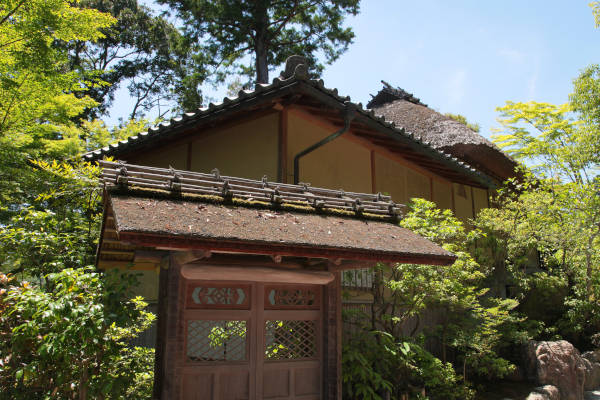 |
Sekka-tei and Gate east side |
| The tea room Seiun-ken is beyond the gate. |
|
|
| |
Copyright 2017 Kofuku no Jokei. all rights reserved |
|
|